09 Oct Resolving Allergies and Interrelated Chronic Health Issues


Paul A. Goldberg MPH, DC, DACBN, DCBCN
Founder and Consultant to The Goldberg Tener Clinic
Chronic Disease Reversal
This has been a difficult season for those with sensitivities to tree pollens, weeds, grass and ragweed. Due to changes in the climate with warmer temperatures starting earlier in the Spring and lasting later into the Fall there has been little reprieve for allergy sufferers.
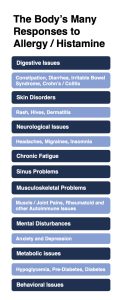
Little recognized by healthcare professionals and laypersons is that inhalant allergies can present themselves in diverse ways. Medical Allergists and Pharmaceutical Companies focus their attention on a narrow range of symptoms. Pollen and Mold Allergies are categorized almost entirely by symptoms of runny noses, watery eyes, sneezing and general malaise. This is a gross underestimation of the effects of pollen and mold on those who are sensitive to them.
When the immune system determines that a substance (e.g., food, pollen, dander, mold or a chemical) we have encountered is potentially harmful, it secretes histamine from mast cells. Histamine causes the mucus membranes including the eyes, mouth, parts of the lung and sinuses to react with the release of mucus for protection. These are not the only areas to react. The entire gastrointestinal tract including the small intestine and colon (where we find the largest percentage of immune cells) are often directly affected and can produce significant symptoms often labeled as colitis, ulcerative colitis, crohn’s disease, spastic colon, irritable bowel syndrome and other GI complaints.
Under the influence of histamine, the heart accelerates to help rid the body of the foreign substance and white blood cells increase in number to neutralize the material. This process produces uncomfortable symptoms e.g., sneezing, runny nose, watery eyes, asthmatic attacks, coughing and fatigue. Other symptoms include diarrhea, mucus discharge from the colon, intestinal cramping (as seen in ulcerative colitis and crohn’s disease), inflammation of the joints as seen in Rheumatoid Arthritis, eczema, hives, and a myriad of other symptoms.
The endocrine system plays a major role in allergies. The individual with blood sugar imbalances, which are common in our population and frequently undiagnosed, is more likely to develop allergies. Those with allergies will likewise frequently develop imbalances in blood glucose regulation. This can manifest as hypoglycemia (low blood sugar) and dys-insulinism (alternating high and low blood sugar). These imbalances in blood glucose levels in turn can result in anxiety, depression, fatigue, muscle and joint pains, insomnia, abnormal cravings for carbohydrates, weight issues, impotence and other chronic health issues.
Detailed laboratory studies including a five- or six-hour glucose tolerance test that is professionally interpreted along with a C-Peptide analysis can determine the presence of blood glucose dysregulation and its involvement with the patient’s allergies/health issues. A fasting glucose and HbgA1C are helpful but by themselves are not sufficient to ferret out blood glucose dysregulation and its role in the patient’s health issues. The following video interview with a patient from our clinic illustrates the close relationship between allergies, blood sugar dysregulation and other interrelated problems including fatigue and digestive problems. Additional video interviews are shown below at the end of the article.
As a professor of chronic disease epidemiology trained at the University of Texas Medical Center and employed by the State of Illinois in the late 1970’s, I noted that patients with autoimmune issues often experienced a crisis with their health issues during the Spring and Fall when pollen reached high levels. Inflammatory bowel disease and rheumatoid issues would often flare during this time. This relationship is largely ignored within medical and alternative medical circles to the patient’s detriment with the prevailing thought that autoimmune disorders are simply cause unknown.
Some of the less recognized symptoms of seasonal allergies are constipation, diarrhea, GERD, acid reflux, nausea and stomach cramping. The skin is another common area where symptoms will appear in the form of hives, rashes, eczema and dermatitis.
Digestive symptoms can arise with little or no upper respiratory symptoms. Excessive histamine is involved but the allergic component is often overlooked by practitioners. If an allergic component is recognized, medically it is addressed with antihistamines which block the action of histamine. Antihistamines include items such as Benadryl and Claritin.
In more severe cases, Steroids (e.g. prednisone) are employed which while suppressing the allergic response, produce serious side effects and complications. Over time, steroids can increase the patient’s allergic tendencies as the endocrine system is weakened by their use resulting in further blood sugar imbalances. Steroids also lead to a thinning of the intestinal membrane making the gut more permeable. This allows foreign materials to more easily permeate through the gut lining and initiate an allergic reaction. (See Article Problems with Prednisone).
The number of people in our nation with allergies is dramatically increasing, particularly among children. One of the disorders now seen increasingly are the inter-related diseases of Eosinophilic Esophagitis, Gastritis and Colitis which the medical profession treats by ongoing courses of steroids. There are many contributing factors to this including the lack of exposure of children to the outside world to develop tolerance to foreign materials and the increased use of pharmaceuticals such as antacids which interfere with proper digestion, particularly that of proteins. (See video on the hazards of acid reducing drugs).
Just as allergies are increasing rapidly so are autoimmune disorders. We consider them to be opposite sides of the same coin. Over the past forty-five years I have observed the intimate relationship between the two…a relationship that is important to consider in helping patients improve their health.
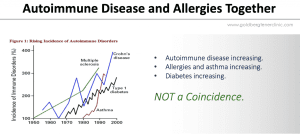
It is important to recognize the many manifestations of inhalant allergies e.g., skin issues, digestive and intestinal disturbances, fatigue issues, behavioral issues, depression, respiratory issues, blood glucose imbalances, etc. which often have important allergic components entirely overlooked by traditional and alternative medical practitioners.
The Bio-Hygienic Re-Creation Approach™
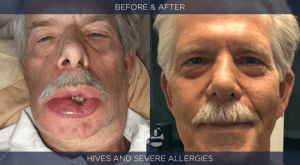
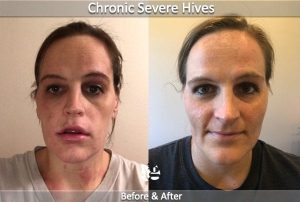
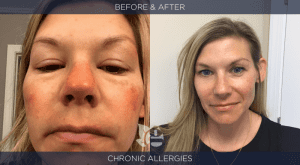
The Bio-Hygienic Approach™ focuses on the causal factors behind allergies and numerous autoimmune disorders not simply their suppression by pharmaceutical agents. Allergy identification is part of the process. We utilize specific testing to evaluate both food and inhalant allergies. An extensive case history is critical to sort out causal factors including genetic tendencies. The case history generally takes a full hour and is just as important as laboratory testing.
Allergy testing, while often an important part of a clinical evaluation, by itself, only reveals what the patient is currently sensitive to not why. It should be noted that allergies, particularly to foods, will change over time and that eliminating foods from one’s diet often only brings about temporary improvement as new allergies often follow in their place. The why of allergies in each person is just as, if not more important, as what items they are allergic to. Food allergies and inhalant allergies are frequently intertwined. The patient with ragweed allergies for instance must eliminate bananas and watermelon during pollen season as they are from the same botanical family.
The immune system interacts intimately with the digestive and endocrine systems and all three deserve special attention in allergic issues. Good digestion is critical to overcoming allergies whether to pollen, mold or foods. The same is true with autoimmune disorders.
Dietary factors in allergies and autoimmune disorders must be examined carefully but care must be taken not to take an exclusively diet focused approach. Commonly we see patients who have put all their eggs in one basket, in this case the diet basket, and have eliminated more and more foods until there is very little left to choose from to eat and yet the health problems still exist. It is not just the foods eaten; it is the way the body processes the food. Carbohydrates must be broken down into glucose, fats into glycerol and fatty acids and proteins into amino acids. If a food is properly digested and broken down into its basic components, allergic reactions are unlikely to occur. Any food, however, maldigested can potentially set off an allergic response. Foods with a higher protein content and those foods that are routinely eaten day after day are the most common offenders. Some complicating issues that are often found upon investigation at our clinic are small intestinal bacterial overgrowth (SIBO), poor diet, heavy metal toxicity, toxicity from glyphosate and other environmental toxins, nutrient deficiencies, chronic exhaustion of the endocrine system, food sensitivities and as mentioned previously, blood glucose dysregulation. The patient’s endocrine system must be strengthened (unlike using steroids which weakens it) so that it can produce the right hormones, in balance with each other, to meet the demands of stress.
Rest and sleep habits must be assessed. A sleep deprived individual is much more likely to have severe allergic problems. Emotional stressors must also be evaluated as emotional ups and downs can be significant factors in the exacerbation of allergic problems and accompanying blood glucose dysregulation.
The Bio-Hygienic Approach, rather than “treating” allergies, seeks out the causal factors behind them and creates the right conditions to foster a balanced, healthy response to the outside world whether the instigating factors be foods, pollens, molds or other foreign materials.
The outcome through such a comprehensive approach is improved health and fewer, less severe allergic responses… without the use of dangerous drugs. As with any chronic health issue there is the need for proper evaluation followed by discipline in enacting a full health building program individualized to the patient.
Below are a few video interviews with patients from our clinic exemplifying the Goldberg Tener Clinic Bio-Hygienic Approach™ in action and the excellent results that are possible. Click here to see additional video interviews.
Related Articles:
- Reversing Autoimmune Disease: Addressing Causes and Building Health
- Blood Sugar: Beyond Diabetes and Hypoglycemia Part I
- Reversing… NOT Treating Asthma
- Reversing Chronic Skin Conditions
- An Effective, Causal Based Approach to Digestive Problems
- Reversing Rheumatoid Arthritis and other Rheumatoid Conditions
- Small Intestinal Bacterial Overgrowth (SIBO): A Symptom of Impaired Health
- Irritable Bowel Syndrome: A Meaningless Diagnosis
- Click here to see our full library of articles.





No Comments